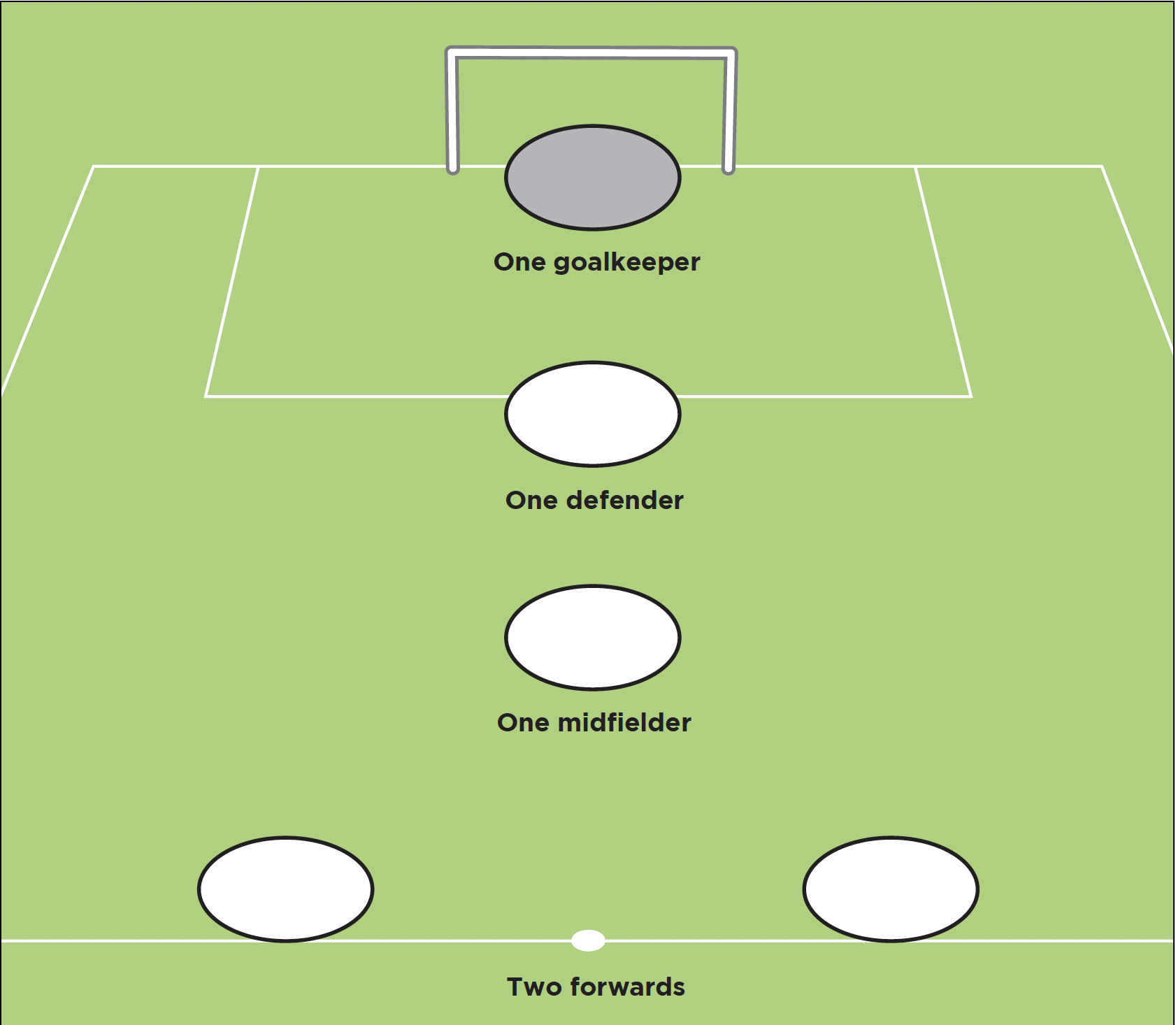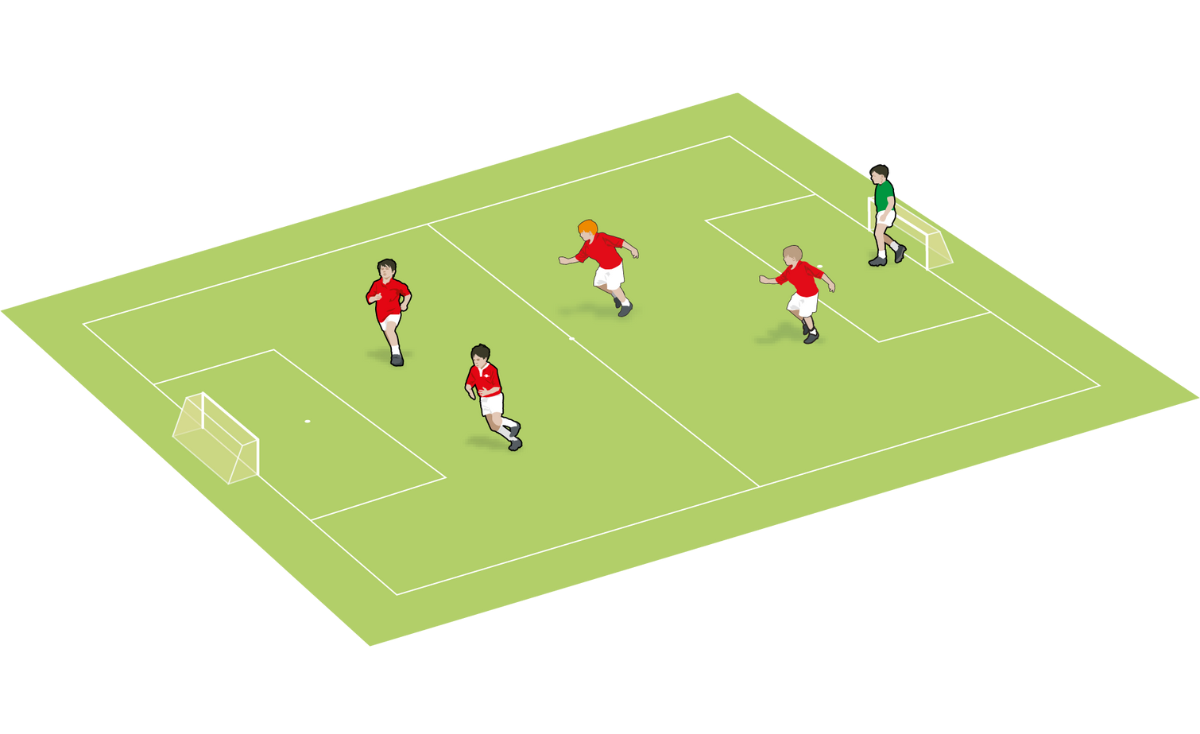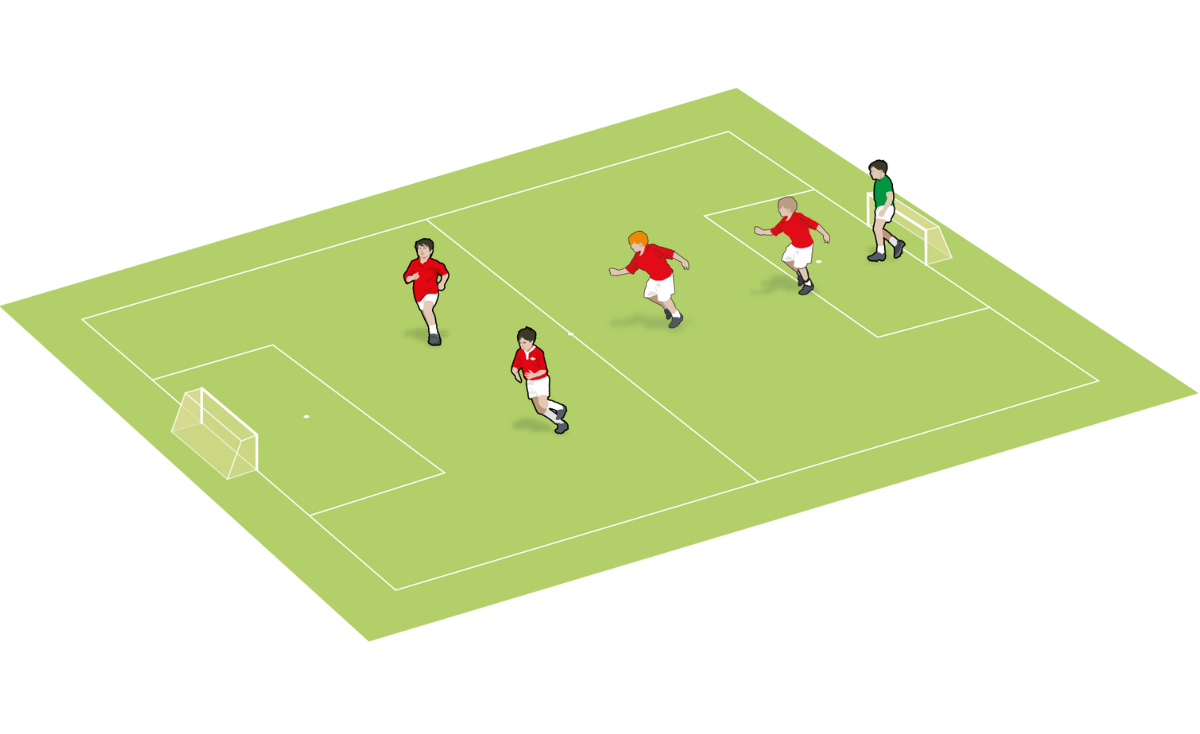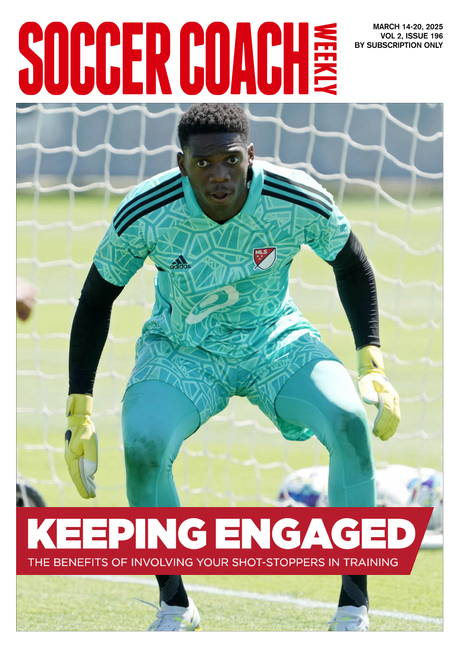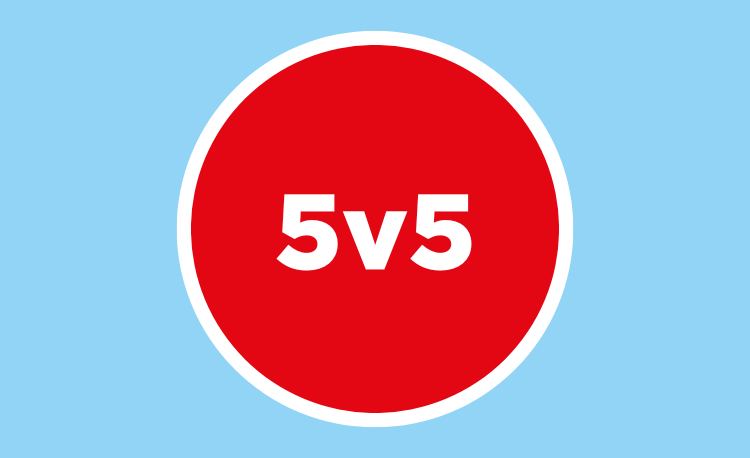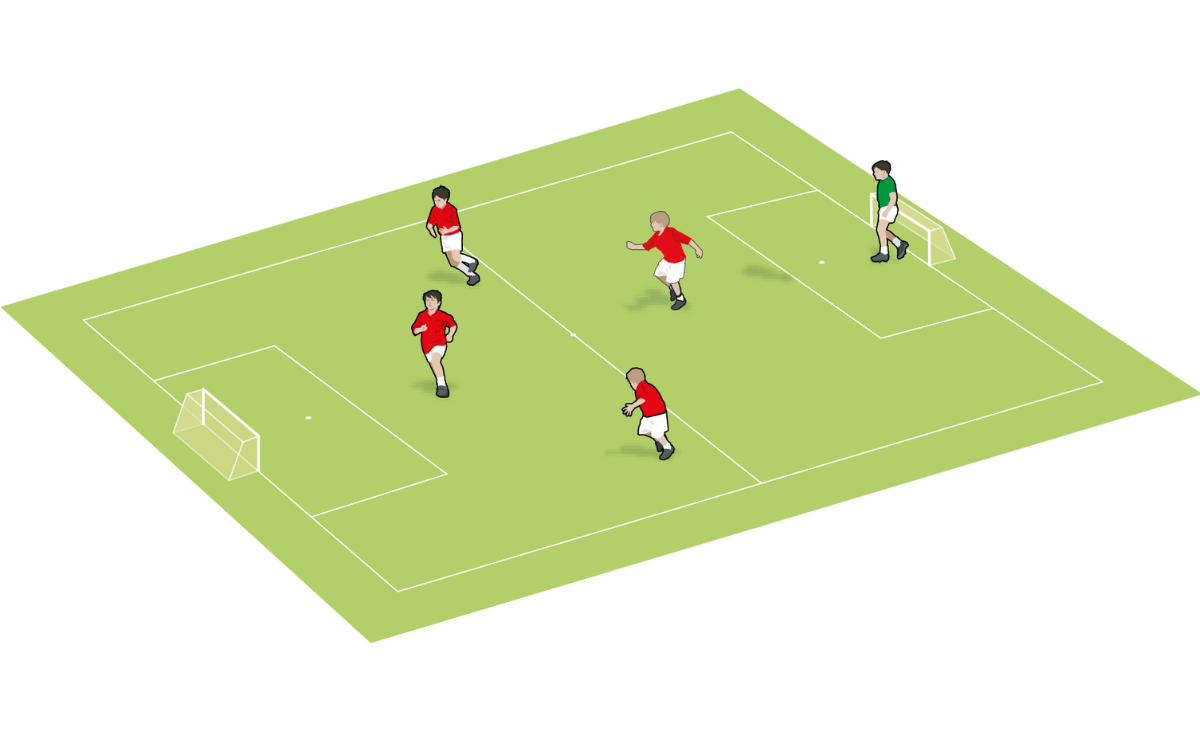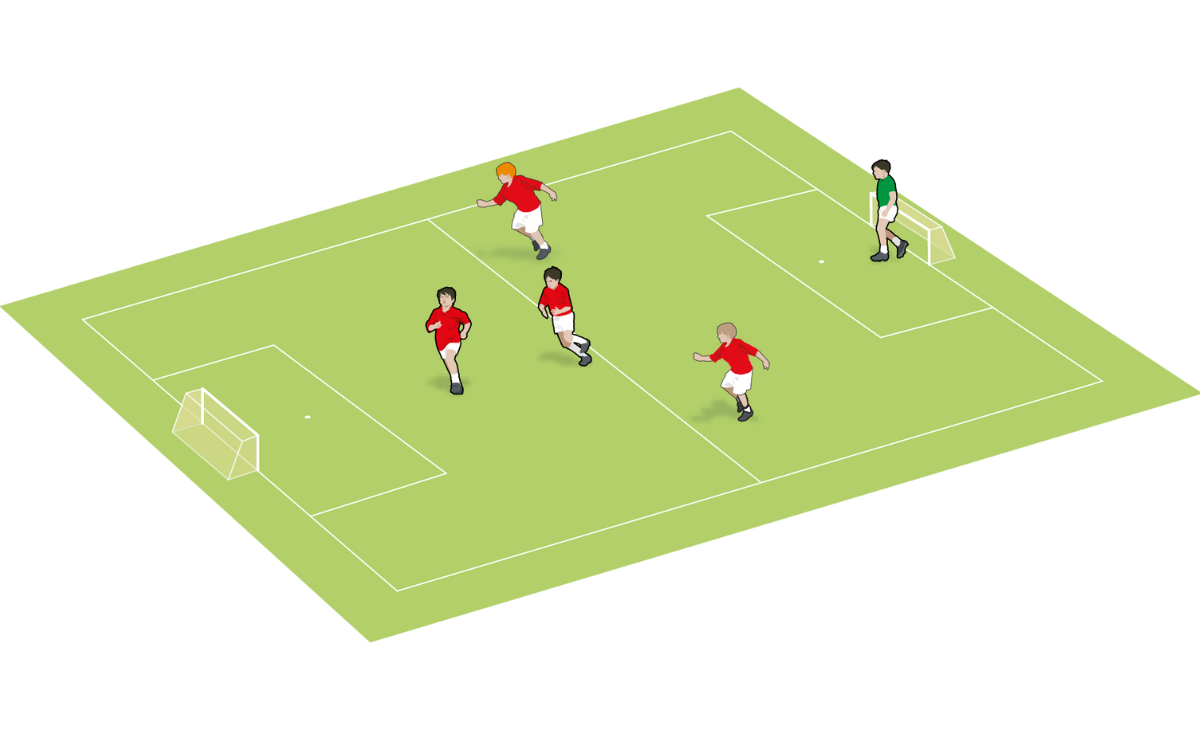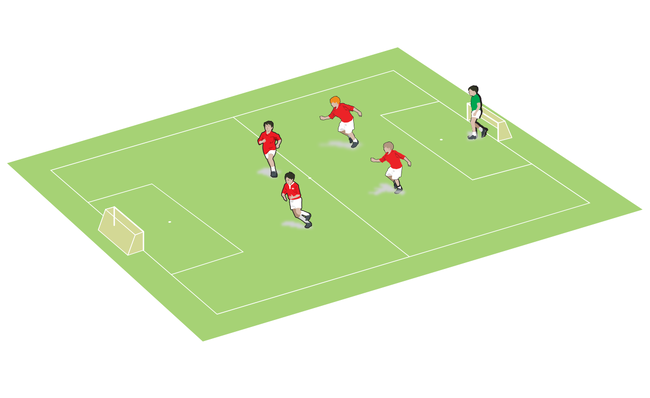5-a-side formation: 1-1-2
Why choose this 5v5 formation? Review the pros and cons, in-possession and out-of-possession principles, and each position
Progresses to: 2-2-2 (7-a-side)
PROS OF THIS FORMATION |
CONS OF THIS FORMATION |
|
|
|
|
|
5v5 1-1-2 - IN-POSSESSION SUMMARY
IN-POSSESSION PROS |
IN-POSSESSION CONS |
|
|
|
|
|
|
|
1-1-2 IN-POSSESSION - BY POSITION
Goalkeeper
This formation will provide the goalkeeper with a number of challenges when they have the ball, as it does not provide them with any natural or ‘safe’ options.
The defender and midfielder, being in the early stages of their development, are likely to occupy similar positions when the goalkeeper has the ball.
The strikers may provide different options, in that they will probably be in a less central position, but will, of course, be further up the field, making it more challenging for the goalkeeper to reach them with a pass.
The keeper will, therefore, most often opt to pass to the defender or the midfielder, who will usually be closely marked. So, the goalkeeper will need to be very accurate with their passing; if it goes astray, the ball could be won by an opponent, who will then be in a position to attack the goal.
Also, because the player they are passing to is likely to be under pressure, this team-mate will sometimes look to play the ball back to the goalkeeper.
When this happens, the opponent who was pressing the outfield player will usually follow the pass and press the keeper.
In this formation, they will come under even more pressure when in possession, compared with other five-a-side shapes.
To deal with this, the goalkeeper will need to develop their ability to react quickly and make swift decisions. This will allow them to pass the ball on before an opposition player is able to close them down.
Defender
The defender is likely to receive the ball from the goalkeeper while they are being closely marked by an opponent.
They must, therefore, begin to learn how to shield and protect the ball, as well as other key skills needed in these situations, including turning and deception.
If they do decide to give the ball back to the goalkeeper, in fear of losing it in a very dangerous position, they need to take great care with their pass.
The goalkeeper will probably need to play the ball quickly after they have received it, so the pass from the defender must allow them to do this. The weight of the pass, and the area it is delivered into, are crucial.
The other key area that the defender will be able to work on, while playing within this formation, is the skill of running with the ball and playing a pass while doing so.
If they manage to get away from the opponent who is pressing them, the pitch will open up for them, giving them space to travel into.
At some point, another opponent will aim to close them down – the defender can then try to release the ball, with the two forwards ahead of them providing good options.
Learning how to do this without stopping their run will make it harder for opposition players to identify when they are going to pass.
Midfielder
One of the main areas of development for the midfielder in this formation is their movement and positioning.
They will have a great opportunity to develop their understanding of where they need to position themselves when other players have the ball.
Because they are playing on their own in a unit, it is possible they will take up similar positions to the defender. This means they may not be able to receive a pass from the keeper, because they are stood between the defender and the ball.
The midfielder must recognise that they need to take up a slightly different position, giving the keeper two options to pass to.
When the two strikers have the ball, we want them to be direct and positive, playing forward as much as possible. However, if they want to play backwards, or it is their only option, they will need a team-mate supporting them.
The midfielder, therefore, should be challenged with following the ball and being in a position where a striker can play back to them, should they need to do so.
The key bit for the midfielder is for them to fully understand exactly where they need to stand.
They do not want to get too close to their team-mate, but they need to be close enough so the ball is able to get to them.
Forwards
The fact there are two forwards, with defensive cover behind them, means these players can afford to be positive and direct, take risks and be creative in their play.
There will be times when one receives the ball and the pair are equally matched up against their opponents, in a 2v2, and times when they will be in an overload situation, a 2v1. These scenarios provide the player who has the ball an opportunity to try to beat their opponent in a 1v1.
The two forwards will also learn about combining with a team-mate, recognising the moments when they should retain the ball and when they should pass it on.
At this stage of their development, we want to encourage players to retain the ball as much as possible. But, if they spot that their partner is in a better position, and make the decision to play the pass, we should recognise they have demonstrated game intelligence and praise them.
The forwards will also get lots of opportunities to practise their finishing. The fact that they will find themselves in a number of different positions in front of goal means they will get to develop a range of finishes.
If they find themselves successful in beating the defender in a 1v1 situation, they are then likely to run directly to the goal. When they do this, they could either shoot as they are running towards goal, or look to get closer and attempt to beat the goalkeeper in a 1v1.
Alternatively, if their striking partner has seen that they are in lots of space and passed the ball to them, the forward will likely have more time and space.
Depending on their exact position on the pitch, they could perform any number of finishes, such as a one-touch finish, or a calm, placed finish.
5v5 1-1-2 - OUT-OF-POSSESSION SUMMARY
Related Files
OUT-OF-POSSESSION PROS |
OUT-OF-POSSESSION CONS |
|
|
|
|
1-1-2 OUT-OF-POSSESSION - BY POSITION
Goalkeeper
This formation will test the goalkeeper in all aspects of their game, as there aren’t any particular areas of the pitch the opposition will predominantly attack.
It might be expected that they will have the most success in wide areas, as the one defender and one midfielder are protecting the centre of the pitch.
But, the fact that there are only two players in the centre means the opposition are just as likely to attack these central areas.
To aid with defending, we can encourage the goalkeeper to support their team-mates by providing them with key information.
The keeper has an advantage over all of the other players, as they are able to see everything ahead of them, including things that their team-mates can’t spot.
With the team likely to be disorganised at times, and players trying to recover and win the ball back, it is likely that most of the outfield players will concentrate on the ball and little else.
This will mean some opposition players will find themselves in space and unmarked. The goalkeeper can play their role by identifying this danger, then letting their team-mates know about it.
Defender
This player will come across a whole range of situations in which they can practise their defensive capabilities, such as defending face to face, defending from behind and racing an opponent to reach the ball.
In fact, defenders are more likely to get increased exposure to these situations in this formation than in other five-a-side shapes.
Ideally, though, we should try to prevent these situations, as the defender is likely to be on their own.
To do so, we can teach the defender how to prevent the opposing player from receiving the ball in the first place – or, if this isn’t possible, stop the player from progressing forward.
We should challenge the defender to try to intercept as many passes as they can by getting to the ball before their opponent. This can be quite risky, because, if they do not judge it right, their opponent could receive the ball with a free run at goal.
It can be argued that, in this formation, it is worth the risk in order to try to prevent a 1v1 situation. We can talk to the defender about ‘pinching’ the ball, and going to meet it, rather than waiting for the opponent to receive it and then trying to win it.
We want them ’defend on the front foot’, by being aggressive, but fair and proactive, in their defending.
Of course, they can’t be expected to intercept it every single time – and when they can’t get to it first, we want them to try to win the ball as soon as their opponent receives it.
In these instances, applying immediate pressure will make it really challenging for their opponent to keep hold of the ball and travel towards goal.
We then want the defender to try to stop the opposition player from getting closer to the goal, while also trying to force a mistake so that they can steal the ball.
Midfielder
In possession, this player is encouraged to follow the ball to support their team-mate who has it – and this can easily extend into their defensive duties.
When the team loses the ball – specifically in the initial moments when they have just lost possession, and are transitioning to defence – the midfielder is likely to be close to the ball.
When this happens, we should encourage them to try to win the ball back straight away.
As soon as they see an opposition player gain possession, they should try to press them immediately and win the ball back, by defending on the front foot.
It must be expected that, sometimes, they won’t be successful, and that the opposition will be able to progress forwards up the field and attack the goal, with just the defender in their way.
The next task for the midfielder is to not give up if they are unsuccessful in their attempt to win the ball back.
Instead, they should make a recovery run and support the defender in protecting the goal.
At this stage of their development, we can’t ask the midfielder to make a decision on whether to go to the ball or identify a space that needs filling or protecting.
We should simply focus on getting them to react to being beaten and running back to help the defender.
Forwards
As there are two forwards, with very little behind them, it makes sense that we ask them to try to win back possession high up the pitch, and prevent the opposition from getting into areas where we are outnumbered and the ball is close to goal.
It is easier for the strikers to do this when the opposition plays with two defenders rather than one, because decisions about which player they should press are simpler.
Essentially, the forwards select a player each and, when their player has the ball or is about to receive it, they start to press.
If the other team plays with just one defender, it means there are further options for them elsewhere – and, if both forwards concentrate on the defender, it could make it easy for the opposition to progress up field.
To support the forwards, we can identify which players they should try to win the ball from. This may also require the help of the midfielder.
For instance, if the opposition plays in a 1-2-1 formation, we can ask the midfielder to press the defender, while the two attackers concentrate on their midfielders.
We can also give the two forwards a challenge to try to win the ball back straight away if they lose it.
Because we have already asked the midfielder to do the same, we want the forwards to help them by ’doubling up’ on the opponent, so that it is really difficult for that player to get away from the pressure by either dribbling or passing.
The natural reaction for the striker is to watch the midfielder challenge for the ball and wait to see what happens.
What we want them to do instead is to understand that two is better than one, and apply pressure, too.
Newsletter Sign Up
Coaches Testimonials

Gerald Kearney, Downtown Las Vegas Soccer Club

Paul Butler, Florida, USA

Rick Shields, Springboro, USA

Tony Green, Pierrefonds Titans, Quebec, Canada
Subscribe Today
Discover the simple way to become a more effective, more successful soccer coach
In a recent survey 89% of subscribers said Soccer Coach Weekly makes them more confident, 91% said Soccer Coach Weekly makes them a more effective coach and 93% said Soccer Coach Weekly makes them more inspired.
*includes 3 coaching manuals
Get Weekly Inspiration
All the latest techniques and approaches
Soccer Coach Weekly offers proven and easy to use soccer drills, coaching sessions, practice plans, small-sided games, warm-ups, training tips and advice.
We've been at the cutting edge of soccer coaching since we launched in 2007, creating resources for the grassroots youth coach, following best practice from around the world and insights from the professional game.
